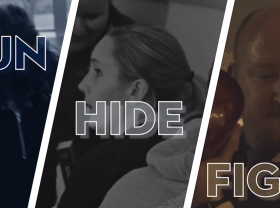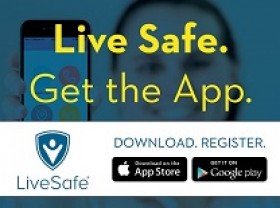Fire and Life Safety Training
To request in-person training please contact the Fire and Life Safety Director at ccolson@georgiasouthern.edu.
Knowing general fire safety tips and practices can help ensure you and the university is safe from a fire emergency. Here are a few fire safety tips you should know:
- Eliminate fire hazards by keeping your workspace and resident free of combustible waste build-up.
- Ensure you know two ways out and your evacuation plan
- Keep all pathways to an exit and out of a building free of items that could create a tripping hazard or becoming trapped.
- Ensure you have a working smoke detector in your place of residents
- Keep all combustible materials away from heating sources.
- Inspect and use only electrical components that are in good condition and use as directed.
- Avoid overloading electrical outlets and strips.
- Follow safe cooking practices.
- Know where fire extinguishers are located and how to use them.
- If the fire alarm activates, leave immediately.
- Do not use open flames.
- Follow all Georgia Southern fire and life safety guidelines
For more fire safety tips and practices, please check out the presentation below.
Cooking fires are the primary cause of residential fires and injuries with two-thirds of all residential fires starting in the kitchen. It’s a necessary task that we all do and most daily. Here are some cooking safety reminders to help ensure a safe and positive outcome each time you are in the kitchen:
- Be alert and never cook when sleepy or under the influence
- Never leave food being cooked on a stovetop unattended and keep a close eye on foods inside ovens and microwaves
- Keep your cooking areas clean and free of combustible materials (i.e.. Potholders, towels, rags, drapes, packing, etc.) that could start a fire. This also includes food or combustible items that may accumulate underneath the stovetop burners
- Turn the pot handles inward so they can’t accidentally be knocked off
- Wear short, tight-fitting clothes or roll up the sleeves to prevent clothing from encountering heat sources
- Always follow the directions on the packaging of food being cooked
- If a fire occurs within an oven or microwave, keep the door closed, turn off the oven or unplug the microwave
- If a fire occurs on a stovetop, turn off the burner, smother the fire by using baking soda or lid and/or use a fire extinguisher to extinguish the fire if safe to do so
- If you need to use a fire extinguisher, remember the acronym P.A.S.S
- P – Pull the pin
- A – Aim the nozzle at the base of the fire
- S – Squeeze the handle
- S – Sweep the nozzle slowly from side to side
- Never put water on a cooking fire as items like grease react with water and intensify the fire
- Should a fire occur, remember the lifesaving acronym R.A.C.E
- R – Rescue occupants in immediate danger
- A – Alert other occupants of the building by activating the buildings fire alarm system
- C – Contain the fire by closing doors and windows on your way out
- E – Extinguish or Evacuate
- Regardless if the fire is small or goes out, ALWAYS call 911 and activate the building’s fire alarm system. This ensures the fire department can check to ensure there is no hidden fire and allows other occupants early notification of an incident so they can safely exit the building
Most fire extinguishers on Georgia Southern campus are multipurpose, dry chemical units that are rated to be used on Class A, B and C fires. Fire extinguishers are strategically located throughout all of our buildings, and you are never more than 75′ from one. It is important to understand how a fire extinguisher works and how to properly use one to keep you and others safe as well as help minimize potential damages from a fire. Here are some useful tips if you ever need to use one.
- Classification of fire extinguishers
- Class A – Ordinary combustibles such as wood and paper
- Class B – Flammable liquids such as oil and gasoline
- Class C- Electrical equipment such as computers
- Class D – Combustible metals such as magnesium
- Class K – Kitchen fires
- When selecting a fire extinguisher make sure the class rating is compatible to the materials burning
- Always check to make sure the extinguisher is fully charged which can be done by ensuring the arrow in the gauge near the handle is in the green or full section.
- When using a fire extinguisher make sure you can exit the building safely and start approximately 6′ away from the fire. Begin extinguishing the fire utilizing the P.A.S.S method:
- P – Pull the pin
- A – Aim the nozzle at the base of the fire
- S – Squeeze the handle
- S – Sweep the nozzle slowly from side to side at the base of the fire
- If you use a fire extinguisher, follow the RACE (Rescue, Alert, Contain, Extinguish/Evacuate) method and after the incident notify emergency responders as well as input a work order through the TMA system to have a new extinguisher installed.
Fire alarm systems are designed to provide you with early notification of a fire emergency. This early notification gives you time to safely exit a building. Here are a few tips to ensure you make it safely out of a building:
- Never ignore the alarm, assume the alarm is false or it’s a drill. Treat every fire alarm as an actual emergency. Just because you do not see flames or smell smoke does not mean one is not occurring.
- When the fire alarm sounds, everyone must immediately evacuate the building using the closest and safest exit.
- During your evacuation, never use the elevators and do not run or panic.
- Once you have safely made it outside, go directly to the buildings designated meeting area(s) and check in. This helps us ensure everyone is out.
- Never re-enter the building once out unless told to do so by emergency personnel.
- Ensure you know your department and buildings emergency evacuation plan and you study/practice it often.
For tips on creating an emergency evacuation and things to consider when doing so check out the following presentation.
Last updated: 3/25/2022





